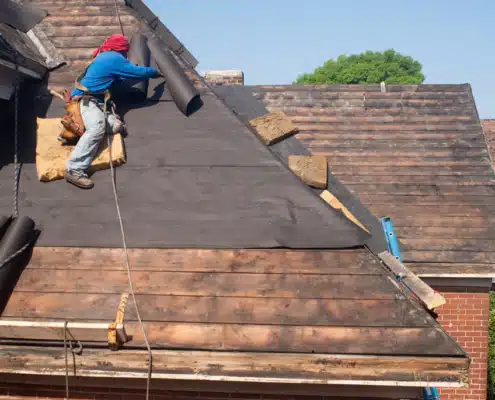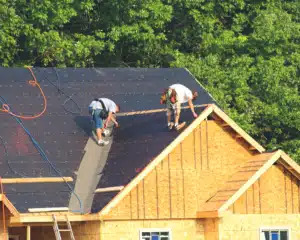When getting quotes for a new roof, there are many options to choose from. Material, color, and lifespan get a lot of attention, while underlayment choices are often overlooked. However, the underlayment choice (also called roofing felt or roofing paper) impacts the cost and performance of your roof. So, what is roofing felt?
What is Roofing Felt?
Roofing felt is a thin layer of breathable, water-resistant material installed between the roof deck and the roofing materials. Functionally, roofing felt is an extra protective layer in case wind-driven rain forces water under your shingles. Plus, it prevents water damage if high winds blow off some roof shingles.
In other words, roofing felt is the last line of defense against moisture damage.
Although roofing felt is one type of roof underlayment, the terms are often used interchangeably.
Is Roofing Underlayment Necessary?
Yes, roofing underlayment is necessary for most roofing systems. Without underlayment, water from heavy rains can seep through cracks and gaps in the primary roofing material, leading to water damage, mold growth, and other types of structural damage.
Additionally, underlayment can help prevent ice damming, wind-driven rain, and other types of weather-related damage, prolonging the roof’s life. While there are some situations where underlayment may not be necessary, such as in certain types of metal roofing systems, for most roofing applications, underlayment is an essential component of a durable, long-lasting roof.
Building Regulations
Plus, in addition to being necessary to protect your home, roof underlayment is required by most building codes and regulations. For example, the 2021 IRC (International Residential Code) states:
“For roof slopes of four units vertical in 12
units horizontal (4:12) or greater, underlayment
shall be one layer applied in the following manner:
underlayment shall be applied shingle fashion,
parallel to and starting from the eave and
lapped 2 inches, Distortions in the underlayment
shall not interfere with the ability of the shingles
to seal. End laps shall be 4 inches and shall be
offset by 6 feet.”
Manufacturer Requirements
And finally, most, if not all, shingle manufacturers require the installation of underlayment materials. For example, Owens Corning requires synthetic underlayment or an equivalent. Failure to comply likely voids the warranty of your asphalt shingles.
So, in addition to just being a good idea, underlayment products are required by code and roofing material manufacturers.
How Much Does Roofing Underlayment Cost?
The roof underlayment cost can vary widely depending on several factors, such as the type of underlayment, the square feet of the roof, the slope of the roof, and the home’s location. On average, roof underlayment costs from $0.15 to $0.50 per square foot for asphalt-saturated felt underlayment, while synthetic underlayment can cost between $0.20 and $0.75 per square foot. Rubberized asphalt underlayment is the most expensive, costing between $0.50 and $2.00 per square foot.
However, keep in mind that low-slope roofs are more expensive than steep roofs. This is because low-slope roofs require two layers of protective underlayment.
Types of Roof Felt/Underlayment:
Several types of roof underlayment are available on the market today, each with unique properties and advantages. However, the most common types of roof underlayment are:
Asphalt-Saturated Roof Felt Underlayment
Also called felt paper, this is the most traditional type of roof underlayment and is made from organic or fiberglass matting soaked in asphalt. It is a cost-effective option that provides essential protection against water infiltration. Although it is available in 15 and 30-pound weight options, it no longer weighs 15 and 30 pounds per square.
Synthetic Underlayment
This type of underlayment is made from various materials such as polyethylene, polypropylene, or polyester. Synthetic underlayment is lightweight, strong, and resistant to tears and punctures. It also has a high resistance to UV radiation, making it ideal for use in hot and sunny environments. Plus, it offers better traction for roofers making it preferred by the roofing industry.
Rubberized Asphalt Underlayment
This underlayment is made from asphalt and rubber, providing superior water resistance and durability. It is also more expensive than other types of underlayment, making it ideal for use in high-end roofing applications.
15 VS 30 Pound Roofing Felt
The difference between 15 and 30-pound underlayment is mainly in their weight, thickness and durability.
The primary difference is that 30-pound underlayment is thicker and more durable than 15-pound. This means it provides better protection against water infiltration, making it a better choice for areas with high rainfall or coastal regions prone to wind-driven rain. It is also more resistant to tearing and puncturing, making it more suitable for roofs with steeper pitches or subject to foot traffic during installation.
In contrast, 15-pound underlayment is thinner and less durable than 30-pound underlayment, making it a more economical option. It is more suitable for roofs with a low slope or in areas with mild weather conditions. It is also easier to handle and install due to its lighter weight.
It’s important to note that the choice between 15 and 30-pound underlayment will depend on several factors, such as the climate, roof slope, and the roofing material used. Therefore, it’s always best to consult a professional roofing contractor to determine the most suitable type of underlayment for your particular roof.
Do You Need 30-pound Roof Felt?
Two factors determine the need for 30-pound roofing paper over 15-pound – wind and slope. For example, high-wind areas like Florida require 30-pound roof felt. In addition, many roofers recommend 30-pound underlayment for slopes greater than 7/12.
So, a typical 4/12 roof on a small rancher here in Richmond, Virginia, only requires 15-pound underlayment.
Keep in mind that some new shingles and specific roof warranties require heavier products or synthetic roofing underlayment.
Is Synthetic Roof Underlayment Worth It?
Yes, synthetic roof underlayment is often worth the extra money. Synthetic underlayment is a high-performance alternative to the traditional asphalt-saturated felt underlayment, providing several advantages.
One of the most significant advantages of synthetic underlayment is its durability. Synthetic underlayment is made from various materials, such as woven or non-woven polypropylene, fiberglass, or polyester, which provide superior strength and durability compared to felt underlayment.
It is also resistant to tearing, puncturing, and UV radiation, making it an excellent choice for areas with high winds, severe weather conditions, and prolonged exposure to sunlight.
Another advantage of synthetic underlayment is its lighter weight and greater ease of installation. Synthetic underlayment is generally more lightweight than felt underlayment, with installation markings printed on it, making it easier to handle and install. It also comes in larger rolls, which means fewer seams and less time and effort required for installation.
In addition to its durability and ease of installation, synthetic underlayment also offers better protection against water infiltration. In addition, it is often more water-resistant than felt underlayment, providing additional protection against water damage and mold growth.
Plus, some new shingles and specific roof warranties require synthetic products.
Installation Best Practices:
Installing roof underlayment is a critical step in the roofing process, and proper installation is essential to ensure that it performs as intended. Here are some best practices for installing roof underlayment:
- Ensure that the roof deck is clean and dry before installing the underlayment.
- Start at the bottom of the roof and work your way up, overlapping each layer by at least 6 inches.
- Use roofing nails or staples to secure the underlayment, making sure to space them appropriately.
- Cut the underlayment around roof penetrations, such as vents or chimneys, to ensure a watertight seal.
- Use manufacturer-recommended installation methods to ensure that the underlayment performs as intended.
In conclusion, roof underlayment is an essential component of any roofing system. It provides an extra layer of protection against water infiltration and other weather-related damage, prolonging the roof’s life. By choosing the right type of underlayment and following proper installation practices, you can ensure that your roofing system is strong, durable, and reliable for years to come.
Final Word
Roofing felt, or roof underlayment, is a waterproof barrier that acts as a second (and final) layer of defense against leaks. The best roof underlayment depends on your roof slope, roofing material, and wind conditions in your area. As a general rule, synthetic roofing felt is the best option. But if it’s not in your budget, traditional felt paper is also an effective solution that has performed well for decades.
As an Amazon Associate I earn from qualifying purchases. So I provide you with you relevant knowledge and products to make extra money 🙂





